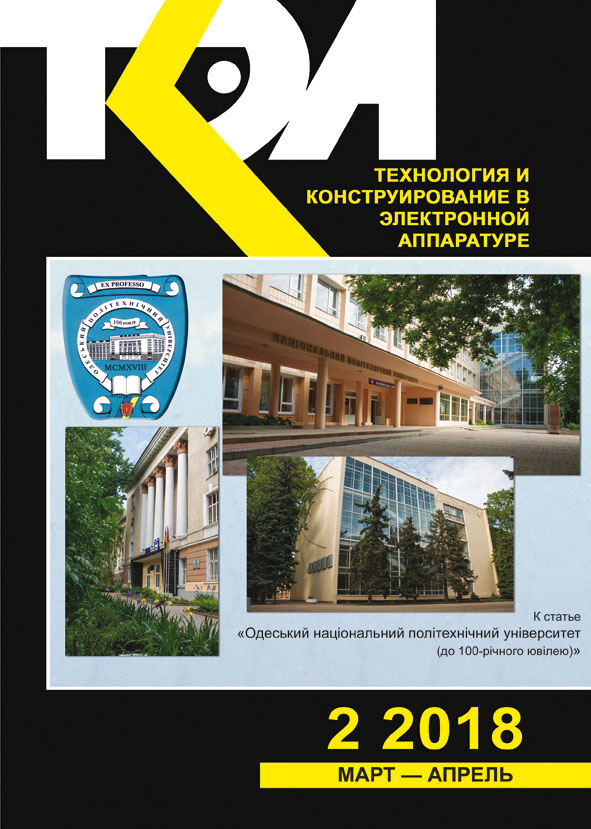Photocapacitor based on nanocomposite n-InSe<RbNO3>
Abstract
The n-InSe<RbNO3> nanocomposite material was obtained by the method of intercalation of the InSe layered single crystal from a melt of RbNO3 ferroelectric salt, which can be used for the production of a high-specific capacitance photoconductor. X-ray analysis of the structure, AFM-imaging of the surface and measurement of dielectric frequency characteristics of the samples were carried out. It was found that the intercalated InSe<RbNO3> samples keeps the type of monocrystalline structure, and the spectrum of X-ray diffraction pattern indicates the implantation of the intercalant in the van der Waals gaps of layered InSe single crystal with an increase in the parameters of the crystal lattice.
AFM images of the surface of nanocomposite material layers show the RbNO3 islands in the form of nanosized rings. The islands' height does not exceed the width of van der Waals gap for InSe, which is ≈ 0,35 nm, and the average outside diameter of the rings is ≈ 50 nm. The ensemble of nanorings is characterized by a high surface density in (0001) plane of the crystal layers (109—1010 cm–2). Thus, the physical phenomena of self-organization of nanostructures with ionic conductivity on the surfaces of layers with a molecular type of bond are used in the making of nanocomposite material for the proposed photoconductor. This allows us to obtain arrays of nanosized 2D inclusions with ionic conductivity and with given geometrical sizes, morphology and spatial distribution in a matrix of a layered crystal.
The developed photoconductor has a high specific electrical capacity, a high coefficient of overlapping of the capacity (≈ 109) in the light, has the ability to accumulate electric charge, it can be used as a low-voltage semiconductor device in optoelectronic memory systems, in photoelectric sensors, in light energy converter and in the storage of electric energy.
References
Bakhtinov A.P., Vodopyanov V.N., Kovalyuk Z.D., Netyaga V.V., Lytvyn O.S. Electrical properties of hybrid (ferromagnetic metal) — (layered semiconductor) Ni/p-GaSe structures. Semiconductors, 2010, vol. 44, iss. 2, pp. 171-183. https://dx.doi.org/10.1134/S1063782610020077
Bozhevol’nov V.B., Yаfyаsov A.M., Konorov P.P. [Formation of heterostructures based on cadmium-mercurytellurium compounds in a semiconductor-electrolyte system]. Prikladnaya Fizika, 2005, iss. 5, рр. 98-102 (Rus)
Kolbasov G.Yа., Gorodyskii A.V. Protsessy fotostimulirovannogo perenosa zaryаda v sisteme poluprovodnikelektrolit [Processes of photostimulated charge transfer in a semiconductor-electrolyte system]. Moscow, Nauka, 1993, 190 p. (Rus)
Schefold J., Vetter M. Solar energy conversion at the p-InP/vanadium3+/2+semiconductor/electrolyte contact a study based on differential capacitance and current-voltage data. Journal of the Electrochemical Society, 1994, vol. 141, no. 8, pp. 2040-2048. https://dx.doi.org/10.1149/1.2055057
Lee M.M., Teuscher J., Miyasaka T., Murakami T.N., Snaith H.J. Efficient hybrid solar cells based on meso-superstructured organometal halide perovskites. Science, 2012, vol. 333, no. 6107, pp. 643-647. https://dx.doi.org/10.1126/science.1228604
Zuev V.A., Popov V.G. Fotoelektricheskie MDPpribory [Photoelectric MIS devices]. Moskow, Sov. radio, 1983, 175 p. (Rus)
Medzhidov A.B., Muradov R.M., Mekhtieva S.I., Aliev I.M. [Capacitive characteristics of Ni-GeO-GaSe structures under illumination]. Izv. AN Azerb., ser. FTMN, 2003, vol. 23, no. 2, pp. 128-134. (Rus)
Bakhtinov A.P., Vodopyanov V.M., Kovalyuk Z.D., Netyaga V.V., Tkachuk I.G. [New nanocomposite ferroelectric materials–layered crystals of n-InSe and p-GaSe]. Nanosistemi, Nanomateriali, Nanotehnologii, 2017, vol. 15, no. 1, pp. 83-90. (Ukr)
Schimotani H., Asanuma H., Tsukazaki A., Ohtomo A., Kawasaki M., Iwasa Y. Insulator-to-metal transition in ZnO by electric double layer gating. Appl. Phys. Lett., 2007, vol. 91, no. 8, pp. 082106(1)-082106(3). https://dx.doi.org/10.1063/1.2772781
Segura A., Guesdon J.P., Besson J.M., Chevy A. Photoconductivity and photovoltaic effect in indium selenide. J. Appl. Phys., 1983, vol. 54, no. 2, pp. 876-888. https://dx.doi.org/10.1063/1.332050
Copyright (c) 2018 photocapacitor, intercalation, III-VI semiconductor, ferroelectric, nanocomposite

This work is licensed under a Creative Commons Attribution 4.0 International License.

